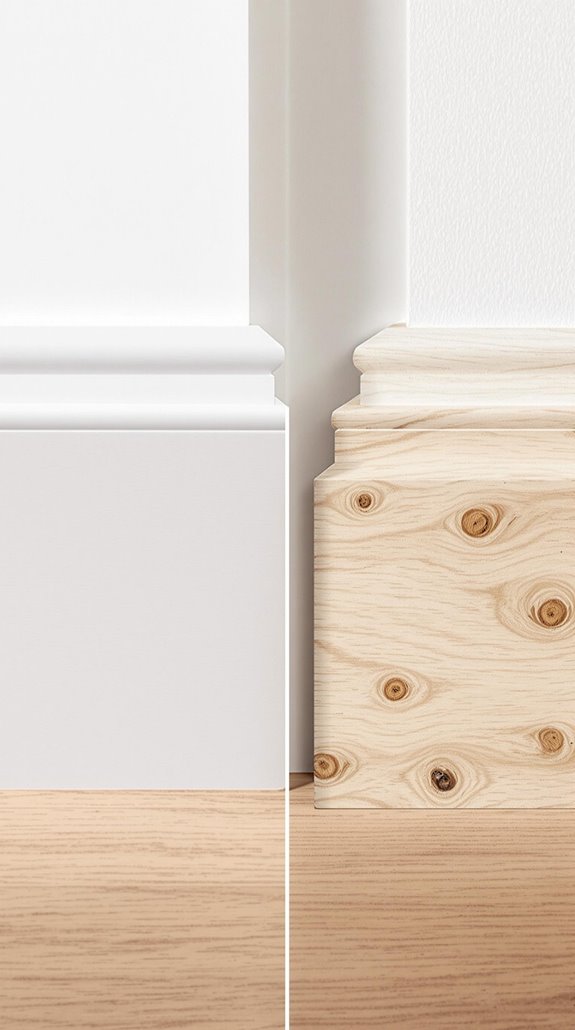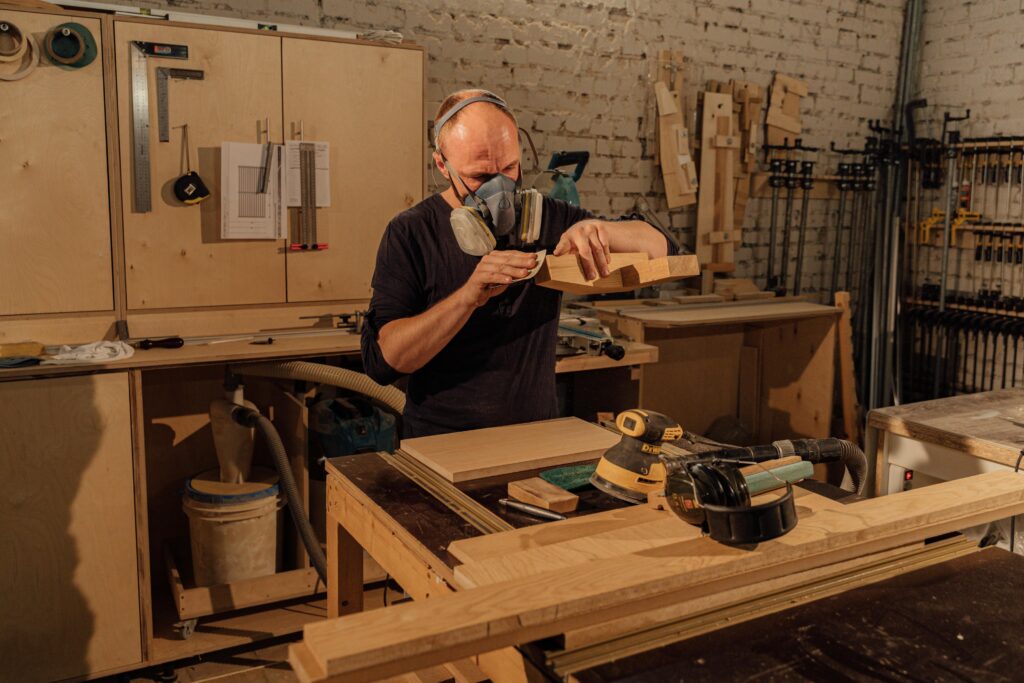I’ve installed both MDF and pine skirting in countless UK homes, and I can tell you the choice isn’t as straightforward as many homeowners think. While MDF dominates the market due to its consistent finish and lower cost, pine offers distinct advantages that could make it the superior choice for your specific situation. The material you select will impact your home’s appearance, maintenance requirements, and long-term durability in ways you might not expect.
Key Takeaways
- MDF offers superior impact resistance in high-traffic areas, while pine is prone to dents due to its softer composition.
- Both materials start at £2 per metre, but MDF is more economical as it comes pre-primed unlike pine.
- Pine naturally resists moisture better than standard MDF, making it superior for humid environments like kitchens and bathrooms.
- MDF provides smooth, blemish-free finishes ideal for painting, while pine showcases natural grain patterns for stained finishes.
- Pine allows for in-situ repairs when damaged, whereas severe MDF damage typically requires complete replacement of sections.
Material Composition and Surface Characteristics Comparison

Understanding the fundamental differences between MDF and pine skirting starts with examining their material composition. I’ll break down what makes each material unique for your home.
MDF comprises compressed wood fibres bonded with resin under high pressure, creating a uniform, engineered product. You’ll find it lacks natural defects like knots, ensuring consistent density throughout. Pine, conversely, is natural softwood featuring visible grain patterns and organic variations in texture.
Surface-wise, MDF delivers a smooth, blemish-free finish that’s perfect for painting applications. Pine showcases natural grain texture that works beautifully with varnished or stained finishes. While MDF requires priming to prevent moisture damage, pine may need knot-filling and sanding for seamless results. MDF offers predictable colour consistency, whereas pine provides authentic wood character. Many suppliers offer MDF skirting boards that are pre-primed or finished, which can streamline your installation process.
Cost Analysis and Budget Considerations
Beyond material characteristics, budget considerations greatly impact your skirting board decision. Both MDF and pine skirting start at approximately £2 per metre, making material costs comparable initially. However, pine requires additional priming and painting since it doesn’t come pre-treated, whilst MDF often arrives pre-primed, saving paint costs and labour time. Additionally, it’s important to consider potential hidden costs such as disposal fees or unexpected repairs during installation. Labour costs typically range £150-£200 per day, with installation usually taking one day regardless of material choice. Pine’s finishing requirements may extend project duration. The cost-efficiency ranking places MDF as the more economical option compared to pine for most homeowners.
Painting Requirements and Finish Options
While both materials accept paint finishes, their preparation requirements differ markedly and will impact your project timeline. I’ll walk you through what you need to know for each option.
MDF typically arrives factory-preprimed, saving you initial sealing work. However, you’ll need to seal any unprimed edges and apply undercoat plus topcoat for durability. Pine requires knot-sealing primer to prevent resin bleed-through, followed by at least one undercoat before your final paint.
Both materials need 220-grit sanding between coats for proper adhesion. Pine offers the advantage of natural varnished finishes if you prefer showcasing wood grain, while MDF only accepts painted finishes due to its manufactured composition.
For longevity, I recommend hard-wearing, easy-clean formulations designed for high-traffic areas. Many professionals suggest spraying all pieces before installation to save time and reduce future maintenance work.
Durability and Long-Term Performance
Having the right finish means nothing if your skirting won’t stand up to daily wear and tear. I’ve found MDF consistently outperforms pine in high-traffic areas due to its superior impact resistance and uniform density structure. While pine’s softer composition makes it prone to dents in hallways and busy zones, MDF’s compact engineering withstands superficial damage better.
However, when damage does occur, pine offers a clear advantage. You can sand, fill, or refinish pine sections in-situ, whereas severe MDF damage typically requires complete replacement. This repairability gives pine an edge in sustainable long-term use.
Both materials achieve decades of service with proper maintenance – MDF through painted seals, pine via regular varnish applications. In moisture-prone environments like bathrooms, pine’s natural moisture resistance provides better long-term performance without the risk of swelling or degradation. Your choice depends on whether you prioritize initial durability or long-term adaptability.
Moisture Resistance and Environmental Suitability
When moisture enters the equation, the fundamental differences between MDF and pine become critically important for your project’s success.
I’ll be direct: standard MDF fails catastrophically when exposed to water. Its compressed wood fibres swell and warp irreversibly, making it unsuitable for bathrooms or humid spaces. Pine’s solid timber construction naturally resists moisture better, though it still requires proper sealing.
For bathroom applications, you’ll need Moisture Resistant MDF at minimum. MR MDF features denser fibres and water-repellent additives that withstand typical bathroom humidity when properly sealed. However, I don’t recommend either material for wet rooms – that’s tile territory.
Here’s what works: MR MDF for standard bathrooms, pine for humid hallways and kitchens. Both demand full painting systems for protection, but pine offers superior long-term resilience. The dense core structure of quality moisture-resistant MDF actively prevents moisture absorption from humid air, making it ideal for typical bathroom environments.
Conclusion
I’d recommend MDF skirting if you’re prioritizing cost-effectiveness and consistent finish quality in standard living areas. However, I’d choose pine if you’re dealing with moisture-prone environments like bathrooms or kitchens, where its natural resistance outweighs the higher cost. You’ll get excellent results with either material when properly installed and maintained. Consider your specific room conditions, budget constraints, and aesthetic preferences—there’s no universal “best” choice, just the right one for your situation.
References
- https://www.homebuilding.co.uk/advice/mdf-or-pine-skirting
- https://www.daniellelevy.co.uk/blogmas-guest-post-skirting-board/
- https://www.youtube.com/watch?v=YVlETxIwSGg
- https://forum.buildhub.org.uk/topic/27672-mdf-vs-pine-skirting-board/
- https://www.periodmouldings.co.uk/blog/pros-and-cons-mdf-vs-solid-wood-skirting/
- https://www.skirting4u.co.uk/blog/post/mdf-softwood-or-solid-wood-which-is-better-for-skirting-architrave
- https://www.tradesuperstoreonline.co.uk/blogs/resources/choosing-between-mdf-softwood-or-solid-wood-for-skirting-and-architrave-a-comprehensive-guide
- https://www.ukworkshop.co.uk/threads/a-dilemma-of-skirting-boards.141031/
- https://metresdirect.co.uk/blogs/how-to-guide/the-best-material-for-skirting-boards
- https://www.myjobquote.co.uk/costs/replacing-skirting-and-architrave

